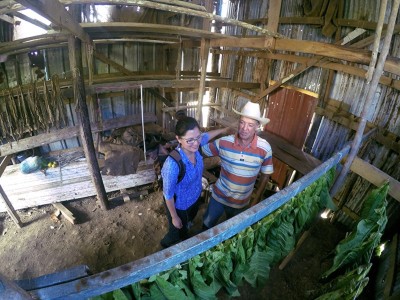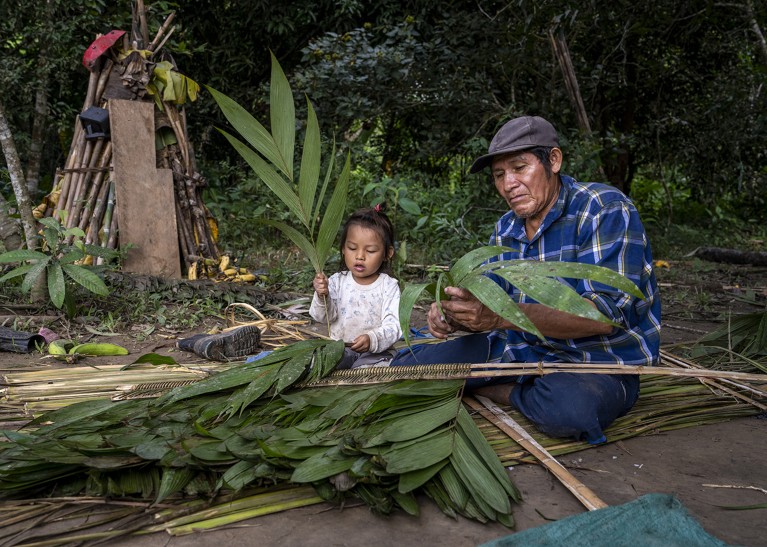
Tsimane’ people in the Bolivian Amazon weave palm leaves together to thatch dwellings.Credit: Joan de la Malla
For the past 20 years or so, a claim has been made in all sorts of outlets, from reports and scientific publications to news articles, that 80% of the world’s biodiversity is found in the territories of Indigenous Peoples. Those using this figure invariably aim to highlight the essential roles that Indigenous Peoples have in conserving biodiversity, and seem to have quoted it in the belief that it is based on solid science.
Numerous studies demonstrate that Indigenous Peoples and their territories are indeed key to safeguarding biodiversity for future generations1,2. But the claim that 80% of the world’s biodiversity is found in Indigenous Peoples’ territories is wrong.
Indigenous knowledge is key to sustainable food systems
The continued use of this number by United Nations agencies, non-governmental organizations (NGOs), journalists, conservation biologists and Indigenous activists and advocates, among others, could damage the exact cause that it is being used to support. Efforts to draw on and prioritize Indigenous Peoples’ knowledge in biodiversity conservation, and to protect their governance and rights, could be undermined if the credibility of individuals and organizations who make this claim is questioned.
The global conservation community must abandon the 80% claim and instead comprehensively acknowledge the crucial roles of Indigenous Peoples in stewarding their lands and seas — and must do so on the basis of already available evidence.
Fact or fiction?
The 80% claim is based on two assumptions: that biodiversity can be divided into countable units, and that these can be mapped spatially at the global level. Neither feat is possible, despite important advances in measuring biodiversity3. In fact, according to the Convention on Biological Diversity — a multilateral treaty to develop strategies for the conservation and sustainable use of biological diversity, involving nearly 200 countries — biodiversity is the “diversity within species, between species and of ecosystems”4. It is not something that can be easily quantified.
Even if researchers resorted to using the number of species present as a measure of biodiversity — a narrow yet common proxy — there are still millions of species that have not been described. Furthermore, there is debate over the proportion of described taxa that represents valid species, and knowledge about the geographical distributions of most species is lacking or incomplete. Data on species counts and distributions are especially likely to be missing for Indigenous Peoples’ lands and seas.
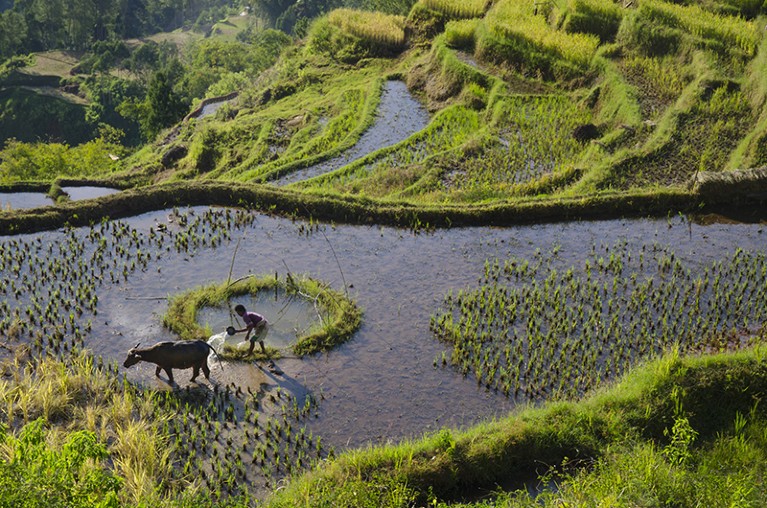
A traditional rice terrace built by members of the Torajan people in Sulawesi, Indonesia.Credit: Joan de la Malla
The 80% claim seems to stem from misinterpretations of previously published statements. As advocates for Indigenous Peoples (three of us identify as Indigenous), we have had discussions about this figure over several years with Indigenous leaders at policy forums, on field visits and in research projects. To track its origins and assess how frequently it has been cited in the literature and in what contexts, we searched for combinations of the words ‘Indigenous’, ‘80%’ and ‘biodiversity’, as well as for combinations of their variants, such as ‘eighty’, ‘percent’ and ‘biological diversity’. We conducted our search using Google Scholar and Clarivate’s Web of Science, and included literature published up to 1 August this year.
Our search found no reference to the 80% assertion before 2002. A report that year by the UN Commission on Sustainable Development, a body tasked with assessing progress on the commitments agreed at the 1992 UN Conference on Environment and Development in Rio de Janeiro, Brazil, stated that Indigenous Peoples “nurture 80% of the world’s biodiversity on ancestral lands and territories”5. Over the next six years, similar unattributed statements were made in four other reports (see Supplementary information). However, judging by how commonly the number is cited, it seems to have been a 2008 World Bank report6 that contributed most to its widespread adoption in the academic literature (see ‘Poor fact-checking’).
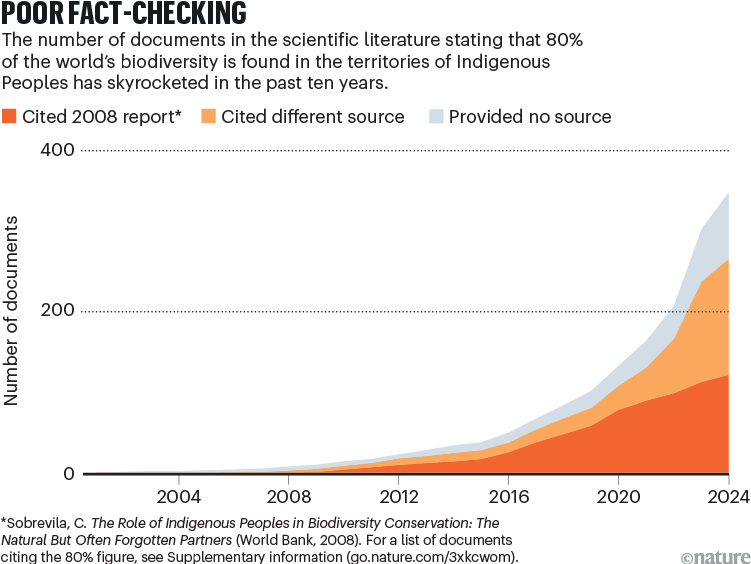
Source: Analysis by Á. Fernández-Llamazares et al.
On the basis of the citations we tracked in our literature review, the earliest potential source for the 80% claim that we could identify is a chapter in the 2001 edition of the Encyclopedia of Biodiversity7. Three documents cite this publication, including a 2009 report by the Food and Agricultural Organization of the UN (FAO)8. It states: “Approximately 80 percent of the world’s remaining biodiversity is found in indigenous peoples’ territories.” But the encyclopedia actually asserts that “nearly 80% of the terrestrial ecoregions are inhabited by one or more indigenous peoples”7. In other words, the original statement, along with the analysis underpinning it, merely quantified the proportion of the world’s 136 terrestrial ecoregions in which Indigenous Peoples were living.
The influential World Bank report6 does not cite the encyclopedia, but instead gives the source as a 2005 publication by the World Resources Institute (WRI), a global non-profit research organization in Washington DC. However, the closest the WRI publication comes to supporting the statement is the observation that seven Indigenous communities in the Philippines were “maintaining over 80 percent of the original high-biodiversity forest cover”9.
Out of nowhere
Among the 348 documents that we found to include the 80% claim are 186 peer-reviewed journal articles, including some in BioScience, The Lancet Planetary Health and Philosophical Transactions of the Royal Society, and 19 news articles targeted at a specialist audience, including one in Nature (see Nature https://doi.org/ndqf (2024) and Supplementary information). The claim has been repeated by the Convention on Biological Diversity10 and by NGOs such as the conservation group WWF. One study in the Proceedings of the National Academy of Sciences even states that Indigenous Peoples “protect approximately 85% of the world’s biodiversity through stewardship”11.
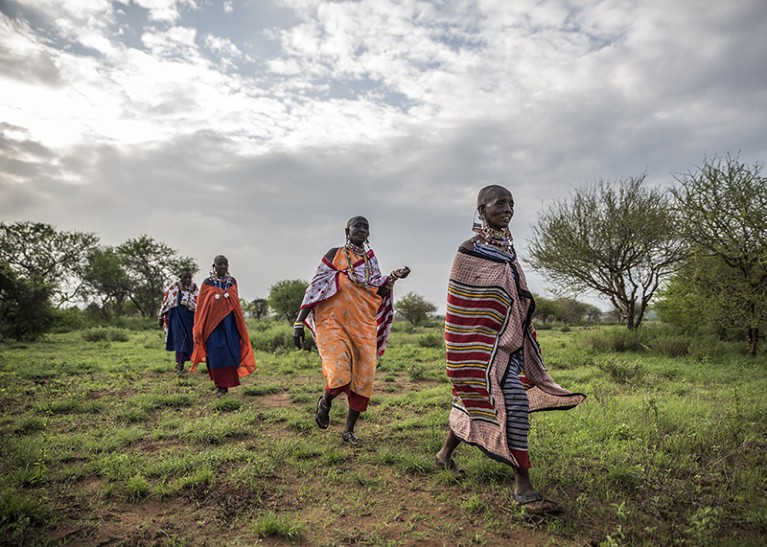
Maasai women in Kenya lead a community-based rangeland restoration project.Credit: Joan de la Malla
The 80% figure has also gained attention in the wider media and has entered popular culture. For instance, the film-maker James Cameron used it in 2022 when publicizing his film franchise Avatar. It has become so engrained in public discourse that even the online fact-checking service GigaFact confirms it to be true (see go.nature.com/4cwxgcd).
Weaving Indigenous knowledge into the scientific method
In our literature review, we found only two documents that questioned the claim: a blog post (see go.nature.com/4dqbavs) and a footnote in a policy brief by the ICCA Consortium, an organization that promotes recognition of the territories of Indigenous Peoples and local communities12. Some Indigenous Peoples’ representatives acknowledge that they have been unable to find supporting evidence for the claim. And some Indigenous leaders have told us that they avoid endorsing the figure.
Our criticism of the 80% claim should in no way undermine decades of effort by Indigenous Peoples’ organizations and others to influence international biodiversity and climate policy. Nor should it detract from the essential and verifiably considerable part that Indigenous Peoples play in the conservation of the planet’s biodiversity. For example, a 2018 analysis13 led by one of us (S.T.G.) indicated that, at the time, Indigenous Peoples managed or held tenure rights over more than one-quarter of Earth’s terrestrial surface — land that intersected with at least 37% of the remaining natural lands worldwide (see ‘Fact, not fiction’).
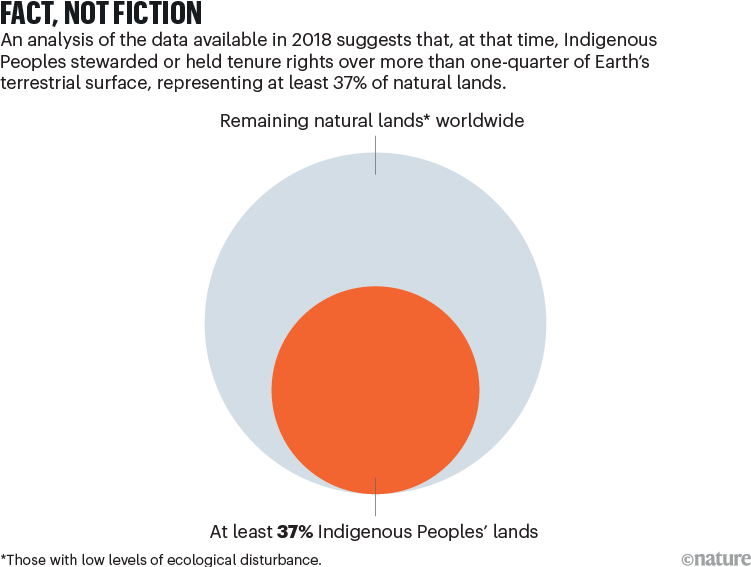
Source: Ref. 13
Subsequent studies have shown that Indigenous Peoples’ lands include more than one-third of the world’s intact forest landscapes (forest ecosystems that show little sign of habitat conversion or fragmentation)1,2,14,15. And around 60% of all terrestrial mammals for which reliable habitat data exist (comprising more than 2,500 species) have more than 10% of their ranges in Indigenous Peoples’ lands16. Compared with protected areas, these lands support at least as many species (when matched for habitat type, location and so on), have fewer alien species and have retained a similar proportion of habitat2,14,15. Indeed, in the past five years, the essential roles of Indigenous Peoples in global biodiversity conservation have been recognized in numerous landmark reports3,17.
On the contrary, our concern is that the 80% claim could undermine these and other rigorous studies — as well as effective efforts to conserve biodiversity by Indigenous Peoples on the ground. Putting aside the fundamental problems with this specific statistic, trying to assign a numerical value to biodiversity on Indigenous Peoples’ territories fails to represent Indigenous values and world views in a meaningful way.
More than a number
The integral connections between Indigenous Peoples and their lands, seas and resources help to conserve biodiversity worldwide in varied ways3,17. This is apparent from scholarship that draws on Indigenous Knowledge across cultures, from oral narratives passed down through generations, and from cultural practices to manage biodiversity17. Assessing the impact of Indigenous Peoples on the safeguarding of biodiversity requires taking into account the many complex interrelations between humans and non-human nature, not just the number of species and ecosystems in a region.
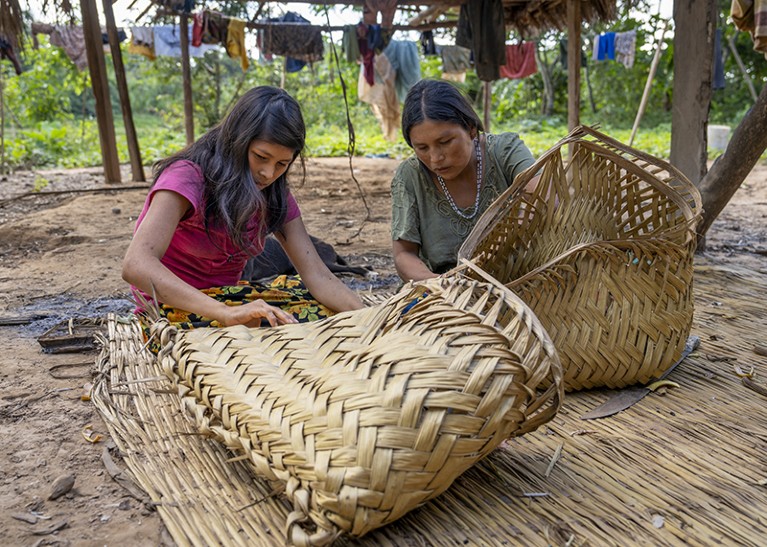
Tsimane’ women in Bolivia make baskets using the leaves of a palm tree.Credit: Joan de la Malla
The implicit assumption behind the 80% claim is that the characterization of biodiversity is complete. Indeed, the implied certainty suggests that Indigenous scholarship and Indigenous Knowledge systems might not be needed to improve understanding of the state of biodiversity on Indigenous Peoples’ lands and in their seas. Although Indigenous Knowledge holders and scholars have long understood the importance of Indigenous governance for the stewardship of biodiversity, an understanding of this is only just beginning to develop among the broader public.
The global conservation community must abandon the unsupported 80% claim, and instead acknowledge more comprehensively the crucial roles of Indigenous Peoples in biodiversity conservation, restoration and stewardship. This means acting in partnership with and supporting the leadership of Indigenous Peoples, recognizing their rights to their lands and seas, and involving them as leaders or as equal partners in decision-making. It means amplifying Indigenous voices in international biodiversity and climate-change forums, and providing Indigenous Peoples with resources so that they can lead their own conservation initiatives.
Genuinely valuing and integrating the ecological knowledge of Indigenous Peoples will lead to a more just and effective approach to conserving the planet’s biodiversity.


